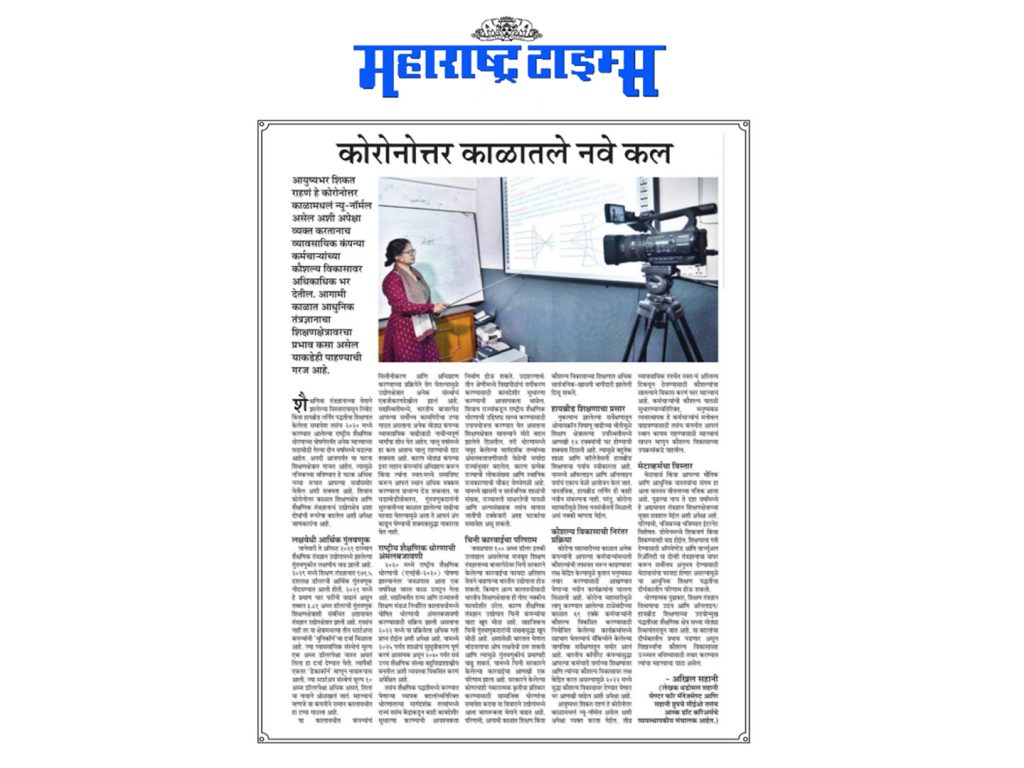Search
Trends to look for in 2022

Dr. Akhil Shahani is the Managing Director of Thadomal Shahani Centre For Management, Shahani Group and CEO, Ask.Careers and runs a range of colleges in business, media, real estate, finance and others. His colleges incorporate global industry-oriented education systems that make their graduates truly employable. He is also a Venture Partner in Kaizen Private Equity, India’s first private equity fund focused solely on the education sector. Besides, Akhil serves as the Chairman of Global Discovery Schools, a franchised chain of 14 innovative schools. In 2020, HSNC University appointed Dr Akhil as a governing board member.
The education sector in India has witnessed many developments over the past few years. Be it the introduction of the New Education Policy (NEP) 2020, or the meteoric rise of the edtech industry and the pandemic-induced transition to online learning, there is an ongoing large-scale churn in the way teaching and learning are conducted, placing the sector on the precipice of change.
Edtech on the rise
With nearly 580 million Indians between the ages of 5-24, India has the advantage of being a ripe market for the online education industry. It is estimated that, by 2026, the online education industry will grow by 11.6 billion. This growth projection is reflected heavily in what the edtech sector has managed to achieve in terms of funding within just the last two years. From being one of the least-funded sectors in 2019, to raising USD 4 billion between January and August 2021, and adding three unicorns and one decacorn to its tally, the edtech ecosystem has been thriving.
These numbers are proof that the edtech revolution is not just a temporary trend fuelled by the pandemic, but a permanent change in the way education will be imparted in the future. The colossal scale of the transfer of knowledge, and the availability of interactive learning, made possible by edtech platforms have breathed in a new life into India’s education system that was traditionally rigid when it came to adoption of tech. Thus, in 2022 and the decades to come, edtech will continue to transform teaching-learning processes for the better.
Hybrid and blended learning models to lead the way
Even before the pandemic happened, traditional methods such as the one-way mode of pedagogy, where teachers spoke and students listened for hours on end, were facing serious questions about their effectiveness. Once the pandemic-induced school closures led to the rapid adoption of online education, both educators and learners were exposed to the benefits of tech-enabled learning. And while e-learning may not replace in-person learning completely in many cases, some technology-led components are here to stay. For example, hybrid learning models entail a combination of face-to-face teaching and distance learning approaches such as video conferencing, online discussion platforms and pre-recorded videos. Meanwhile, through blended learning, educators can incorporate edtech features into in-class lesson plans and activities to supplement and enhance the learning experience for students.
Initially, both these models were slow to be adopted. However, since the emergence of the pandemic, they have become increasingly present in classrooms. A PwC 2020 report titled Re-envisioning Higher Education through Digital Adoption echoes this sentiment, noting that 85 percent of the management they interviewed, from central, state and private higher education institutes, indicated their intention of opting for holistic technology solutions in the near future.
The skilling and employability challenge
Despite all the positive developments discussed above, the education sector in India still has some serious challenges to overcome. Chief among them is the ability to smoothen the path from education to employability in order to tackle the skill gap and growing job crisis in the country. India is poised to be home to one of the world’s youngest populations, with over 64 percent of its people in the working-age group, and we are looking at a significant unemployment problem in the coming years.
Nowhere was this looming crisis more evident than in the videos that came out of Madhya Pradesh last week, where nearly 11,000 applicants lined up for just 15 job openings for peons, drivers and watchmen. The applicants flocked from all corners of MP and even from nearby Uttar Pradesh, and included those with post-graduate, engineering, and MBA degrees. The images and videos of the snaking queues reveal just how dire India’s job crisis is becoming, and the urgent need for the education sector to revamp itself in order to tackle this effectively.
Hence, perhaps one of the most significant and ongoing changes in the education sector is that, right from the primary level up to higher education, there is a sharp focus on industry-relevant skills. Whether it is the NEP 2020 introducing Coding as a subject as early as 6th grade, or the government’s 2015 Skill India initiative to train over 40 crore Indians in various industry-related jobs, the messaging is clear – education has to help cultivate a highly-skilled workforce and lead to better chances of employability for India’s youth.
